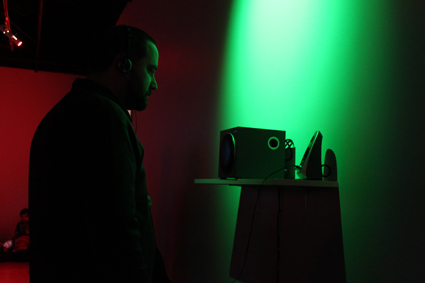attentively, on the edge of hearing
andrew harper, in a silent way, cast gallery

In a Silent Way, CAST
photo Pip Stafford
In a Silent Way, CAST
SOUND ART THAT ATTEMPTS TO ENGAGE WITH SILENCE MAY SEEM DOOMED TO INCONGRUITY IF NOT OUTRIGHT FAILURE, BUT WITH THE STEADY HAND OF CURATOR MATT WARREN ON THE RUDDER A COLLECTION OF THESE DELIBERATELY QUIET WORKS, FILLED WITH SPACE, CAME TOGETHER WELL.
Warren’s best known as a sound and installation-based artist, with this being his first major effort as a curator. What surprised me on first encounter was how easily the work of disparate sound artists came together to produce an exhibition that also sat well with the curator’s own arts practice.
Warren has long traded in the subtle; even when the volume has been intensely loud, or subsonically disturbing, there has always been a strong interest in the quiet and empty spaces between. In conversation around In A Silent Way, Warren noted that the notion of absence is a driving idea in his work. He looks, and listens for that which is not there, discovering that you can miss something—its very absence can create a presence. It’s a hard thing to evoke, and is what has made his work to date seem haunted and emotionally powerful.
In recruiting people who work with sound to create In A Silent Way, Warren gave out a very simple brief: make sound works that investigate silence. This is technically impossible, for silence itself can never truly exist, as John Cage discovered when he visited an anechoic chamber in 1951 and heard the sounds of his own body. Silence is a literal utopia; a poetic idea that occurs only in the imagination. Given this actuality, listening as active became an important focus for the premise of the show—what is it that we hear if we really listen, extending into quiet spaces to seek small occurrences and moments? The curated works became compositions that exist to be played quietly, at the edge of hearing. However, the expectation of focused listening was turned on its head: there were no headphones, instead a dim room lit with the red, green and blue light—from which all colour is constructed for camera, video and television. This delicate hint to mix and create for oneself was certainly inviting.
Most of the works were constructed especially for the exhibition. All were extremely effective as individual investigations of the curatorial theme, and it’s hard to say, given the presentation decisions, if any really emerge as stand-outs. Indeed, that would really work against the intent of the show. What stood out were the moments that occurred organically as sounds interacted. I realised that the blending of Joel Stern’s echoing bells with Gail Priest’s moaning sine waves just as Darren Cook’s slightly woozy playing of a Howlin’ Wolf track lurched into digital shudders, was unlikely to be heard again, given the varying lengths of the looping works. I became quite engrossed at the possibility that only I would ever hear quite that moment. The demand for active engagement was well rewarded.
Nevertheless, the peculiar and obsessive creation that went into UK artist Nicholas Bullen’s work warrants a mention: he recorded a day’s worth of noise from his own house while he was elsewhere. Cherry-picking the recording, he processed and constructed a remarkable sound work that is genuinely creepy.
Potent as well was the responsive performance from the show’s opening event, where Laura Altman and Monica Brooks sat at opposing points in the gallery, gently responding live to the extant sounds, then slowly to each other. Improvising to a moving palette of sound art in a room full of whispering people is a challenge, but the time the two players described with sound hung together with a brittle elegance. People who seem to know their instruments well enough not to demonstrate their skill make fascinating players.
In A Silent Way was a step out of the ordinary for a show based around sound works. I felt as if the installed sounds were a musical instrument and a dance was waiting to happen. The works of varying lengths looped, creating constant change as the sounds intermingled, generating a palpable atmosphere and encouraging me to circle and cross the space again and again, moving to and from sets of speakers attached to the wall like tiny altars. One could be quite deluded at times as to where sound emerged from, given the quiet bleed of the works. The consideration given to the actual install was very precise, and it showed.
After a time another effect became noticeable as I sat on the floor in the space’s centre; the room took on the peculiar feel of a sacred or spiritual place. There’s a moment of secular ecstasy that can sometimes occur with works of art, something like the overpowering feeling generated by the famous Rothko Chapel. While not every work aims to produce transcendence, it is strange and memorable on those very rare occasions one encounters it. This is something that Matt Warren, while not remotely religious, reaches for in his work and achieved with his sensitive curation. The individual works came together as a whole, filling CAST with a cascade of moments that had the peculiar effect of seeming to distort time.
In a Silent Way asked me to question my own notions of sound art, and how much time anyone needs to spend with a work of any kind, time-based or not. Miles Davis, from whom Warren borrowed the exhibition’s title, would likely have approved, given that greatest of players’ command of the rich moment of silence.
All sound works are available as a limited edition CD from CAST. Also visit roomofsilencerecords.bandcamp.com.
In a silent way, curator Matt Warren [2012 CAST Curatorial Mentorship], sound works by Laura Altman, Monica Brooks, Nicholas Bullen, Darren Cook, Lawrence English, Samaan Feick, Gail Priest, Joel Stern, CAST Gallery, Hobart, July 28-Aug 26
RealTime issue #112 Dec-Jan 2012 pg. 43






